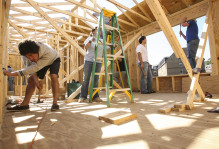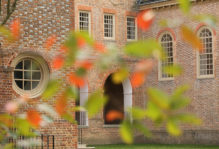Accessing Active Citizenship
Two years ago, I wrote about the member mentality and the Active Citizens Continuum which describes how our perspective on community engagement can change.
When I was first introduced to active citizenship, I thought of it as “The Active Citizen” who collected all the badges for responsibility, justice, service, and social change. Becoming “The Active Citizen” seemed unattainable and certainly not sustainable while also trying to lead a happy healthy life.
Thankfully, being “The Active Citizen” isn’t what active citizenship actually is.
Now I think of active citizenship, and the whole continuum, more like a progression of eye wear. Each new stage lets me see in greater detail the connections between myself, society, the environment, and the work of social change. As I live out my active citizenship, I continue to see new layers to the world and my place in it.
Learning and engaging more with disability justice and accessibility has given me a new wavelength of active citizenship. Now that I am tuned in, I’ve been able to prioritize community and practice active citizenship in ways I never thought to before.*
Here are just a few examples:
- Integrating accessibility into OCE through our accessibility statement, adding default question about accommodations to all of our event registrations, and sharing disability resources with my colleagues for professional development
- Seeking out and consuming more content from disabled creators through social media (@neurodifferent, @alicatsamurai, @shan_no_nosays) and books. Some of my favorite reads include Good Kings, Bad Kings (Nussbaum), Care Work Dream Disability Justice (Piepzna-Samarasinha), Disability Visibility (Wong, ed.), and the children’s book I bought ten copies of to give to all the tiny humans in my life – We Move Together (Fritch, McGuire, Trejos).
- Asking for greater accessibility in my broader community by submitting public comments, including always asking for auto-captions to be turned on during the many Zoom presentations I attend or sharing when I encounter a physical barrier on campus.
- Facilitating opportunities to learn alongside others, like the Disability Action Book Club I led for a year
- Working with The Neurodiveristy Student Group to transform an unused study room in our office into a sensory space through an IDEA grant from W&M. If you’re on campus and haven’t visited the Sensory Space in Blow 314, come on over.
My first thought each morning isn’t how can I dismantle ableism and disability discrimination. But as I go through my day, I am using the lens of accessibility and disability justice to make decisions. This new layer to my active citizenship changes the language I use, adds new questions to my examination of the world, connects me to more people and ideas, challenges my bias and limitations, and compels me to act in new and more inclusive ways. That is what it looks like for me to prioritize community in my values and life choices.
*Yes, I realize that I switched from a visual to an auditory metaphor here.



No comments.
Comments are currently closed. Comments are closed on all posts older than one year, and for those in our archive.